Daily News
by Gail Helmer
[ Send Us News | Archives ]
PC Game News
Tom Clancy's Splinter Cell Slips
Gamespot reports that Splinter Cell will slip its PC version ship date from late January to mid-February.
Source: Gamespot
IL-2 Sturmovik Video Competition Extended
Catrix has announced that they will be extending the video competition until 24th January as some people were having difficulties sending in their files.
Website: IL-2Sturmovik.com
Ubi.com Gaming Zone Alert
Ubi.com will be shutting down their Gaming Zone services for maintenance. Here's the notice from the site:
Military News
Canadian Fighter Pilots Share Milestone
4 WING COLD LAKE - When Lt. (Navy) Dave Morgan, a US Navy exchange pilot with 410 Squadron, climbed into the cockpit of the CF-18 Hornet on December 12, he took part in a historic event.
The global community of Hornets has accumulated a total of five million flight hours and F-18 pilots around the world acknowledged this milestone in mid-December. At 4 Wing pilots from the US, Australia and Canada shared in the moment.
Lt. (N) Morgan led a three-aircraft formation with Capt Dave Turenne, a student at 410 Squadron and Flt.-Lt. Matt McCormack an Australian exchange officer, flying the other Hornets. They conducted a regularly scheduled training mission during the five millionth hour acknowledgement flight.
Canada has been flying the Hornets since 1982 and of the five million hours flown world wide, Canada has contributed close to 500,000.
The twin engines of this supersonic tactical fighter jet deliver over 7,000 kilograms of thrust and speeds of up to Mach 1.8, or over 2,000 kilometres per hour. Canada uses the Hornet for air defence of North America, training with our allies, and deploying on operations around the world. CF-18's from 4 Wing played key roles in the Gulf War and supported NATO operations in Kosovo last year.
There are currently more than 1,200 Hornets flying in 58 active duty, reserve and test squadrons around the world. There are 105 active CF-18s located at air force bases in Cold Lake, Alta. and Bagotville, Que.
New Commandant Takes Osprey Ride
PATUXENT RIVER, Md. (NNS) -- General Michael W. Hagee, the new Commandant of the Marine Corps, entered his name into the history book of naval aviation Jan. 8 by taking the first VIP flight in the V-22 Osprey since the aircraft’s return to flight in late May of last year.
Osprey No. 21 was used for the 20-minute sortie, piloted by Lt. Col. Kevin Gross and Maj. Shawn Healy. The crew chief was Gunnery Sgt. Dennis Oliverio. The flight was conducted from Naval Air Station Patuxent River, Md., home of Naval Air Systems Command (NAVAIR) and headquarters for the V-22 Integrated Test Team (ITT).
“What a blast,” then Lt. Gen. Hagee said after the flight. “The acceleration when we converted from vertical to horizontal flight was unbelievable.”
In addition to the flight, during his visit to Southern Maryland, Hagee also received a program overview from Col. Dan Schultz, PMA-275, and offered words of encouragement and praise to a gathering of engineers and technicians from the Osprey’s ITT.
“I want to congratulate the test team on all that’s been accomplished in recent months,” the general said. “The Marine Corps is depending on you to keep the press on in the future.”
Besides the flight crew, joining Hagee on the flight was Tom Laux, NAVAIR’s program executive officer for Air, Assault, Anit-Submarine Warfare, and Special Mission Programs.
NAVAIR provides advanced warfare technology through the efforts of a seamless, integrated, worldwide network of aviation technology experts.
Source: Navy News
Dexies Keep US Air Force Pilots Awake
WASHINGTON -- In the high-speed, high-stress environment of the combat aviator, it is a fact of life, and Air Force officials are doing what they can to ensure aircrew members are armed with the ability to fight an internal enemy that is potentially as deadly as a surface-to-air missile.
Fatigue was a contributing factor in 391 Air Force aircraft accidents from 1991 to 2002, Air Force safety officials said.
Those officials added that people who have been awake for 24-continuous hours react equivalent to someone with a blood alcohol content of .10, which is considered legally intoxicated in most states. A person who has been awake for 18-continuous hours has the equivalent BAC of .05.
That potential loss of motor skills is what prompted the Air Force to develop the fatigue-management program for aircrews who are tasked with extremely long missions.
According to Col. Tom Hyde, chief of "Checkmate," the Air Force chief of staff's directorate for air and space strategy development, the fatigue-management program is the pilot's set of tools to remain awake and alert during extremely long flights.
"The tools we have available are diet, exercise, sleep cycles and a medication program," Hyde said. "When you (use) all four in combination, it ends up being a reasonable and prudent approach in order to combat fatigue."
When a person is physically fit, Hyde said, the body is better able to handle stresses, including an interrupted sleep cycle, deployment and family separation.
Although most elements of the fatigue-management program are preflight, Hyde said there are some things crewmembers can do to stay alert even while strapped into their ejection seats. Those fatigue-fighting techniques include stretches, G-suit and oxygen system adjustments, and snacking.
The fatigue-management tool of last resort is a doctor-prescribed stimulant.
Only fighter and bomber crewmembers are authorized stimulants, Hyde said, because commanders have the option to augment tanker and airlift aircraft with additional pilots.
The "go pill," as it is commonly called, is a 5- or 10-milligram dose of Dexedrine. Dexedrine is the same medication routinely prescribed to treat attention deficit disorder. At the prescribed dosage, the stimulating effect of Dexedrine wears off after about four hours.
"The dosage is not too strong," Hyde said. "It's just designed to take the edge off."
Before pilots are authorized to fly after taking a "go pill," they must complete a prescribed testing protocol to determine how the medication will affect each pilot's body. The details are recorded in the pilot's medical records.
Before lengthy missions, and after consulting with their commanders and flight surgeons, pilots decide whether or not they want to take the pills with them on the mission. Then, it is up to the individual pilot as to whether or not to take the pill, Hyde said.
"When you walk out the door to fly (an) extended mission, do you have to take it with you? No," he said. "Is it advisable? Sure, but it's up to you whether or not to use it.
"It's (prescribed) under a doctor's care and with commander involvement," he said. "It's done with the full consent of the individual taking it."
Aircraft on bombing runs can approach a target at about 1,000 feet per second, Hyde said. In air-to-air engagements, aircraft can close in on each other at up to double that speed.
"When you get an idea of how fast things are moving through space, there is a lot that can happen as a result of a one- or two-second delay in making a decision," he said.
As a former squadron and group commander who has more than 3,300 flying hours, Hyde knows firsthand how fatigue can affect a pilot at those speeds.
"If you look at those instances where, after the fact, I said 'What was I thinking?' about 80 percent of the time it could be tied back to fatigue," he said.
"Fatigue's a killer out there," he said.
Air Force Risks Air Dominance Without F/A-22
WASHINGTON -- Without the F/A-22 Raptor, the Air Force could face losing its lead in fighter aviation to other nations, said Maj. Gen. John D. W. Corley, director of Air Force Global Power Programs at the Pentagon.
"We need this aircraft," Corley said. "It's the only new U.S. aircraft that will be able to put weapons on target this decade and be capable of defeating next-generation threats."
The Air Force sees the F/A-22 as the key enabler for joint and coalition forces to be able to operate around the clock without fear of attack. The Raptor will also enable the service to operate its other stealth assets - the B-2 Spirit, F-117 Nighthawk and Joint Strike Fighter -- during the day.
"If we begin to hobble this program and begin to reduce what is clearly the best strike aircraft that has ever been produced, then later this decade we will lose the ability to provide unchallenged air dominance over the battlefield for U.S. and allied forces," the general explained.
For more than half a century, American ground forces have not had to worry about threats from enemy aircraft. Corley said he worries that without the Raptor to meet and beat the challenges posed by the next generation of foreign aircraft, this could change.
"That would be a dreadful first for us," he said.
Although there is an estimated $880 million cost increase to extend the engineering, manufacturing and development phase of the F/A-22 program, Air Force officials remain committed to funding any increase from within the program itself.
"We are confident that with the efficiencies and control measures we've put in place, and with better coordination with the contractor, we'll be able to deliver on a great aircraft within the constraints of the $43 billion procurement cap for the program," Corley said.
This extension of the EMD phase is not because of aircraft performance but increased time required addressing avionics software instability and fin buffet issues.
"The F/A-22 is a great aircraft, and its performance to date has been outstanding," he said. "The combination of all aspects -- stealth, supercruise, its revolutionary maneuverability and the integrated avionics -- will give us an unfair advantage over any enemy in the foreseeable future."
The Raptor is needed and Air Force leaders fully support and concur with a "buy-the-budget" philosophy for the F/A-22, according to the general.
"We aren't asking for a removal or expansion of the procurement cap," he said. "We just want the opportunity to make best use of the dollars by stabilizing this program so we can buy the greatest quantity of aircraft with the available dollars."
In the procurement world, reducing the number of aircraft being purchased does not always save money in the long run. In fact, as fewer aircraft are purchased, the cost per aircraft usually increases. If at a later date more aircraft are required, the aircraft must be purchased at an elevated price.
The Air Force experienced this with the C-17 Globemaster III program when it had to reduce the number of C-17s that it wanted to purchase because of similar program instability, Corley said.
However, when the plane finally entered service, the nation saw that there was still a need for more of them, he said. Even though the Air Force has purchased more aircraft, it is not been able to get back to the original cost and must pay a premium price per aircraft.
"Let's not repeat the same mistakes," Corley said. "Let's not keep chipping away at the F/A-22 program. Let's not cause the taxpayer to spend more money to subsequently buy back critical capability. There is an essential need for the F/A-22 in sufficient numbers, just as there was, and is, for the C-17.
"Let's take F/A-22 successfully through testing, stabilize the program and quickly ramp to production rates that field capability critical to our nation's defense," he said.
UAV Aircraft Launched From Submarine
ANNAPOLIS, Md. -- Northrop Grumman Corporation has completed the first of three tests designed to demonstrate that air vehicle payloads such as UAVs can be successfully launched from an inexpensive, expendable capsule after it is released from a submarine.
This test of the Stealthy Affordable Capsule System (SACS), performed in a test pool at the SRI Corral Hollow Experiment Site in Tracy, Calif., successfully met its goal of demonstrating the key technologies of this system, including capsule hydro-stability, payload support and payload ejection in the actual environment.
The next step in the development process is to continue concept refinement including two additional waterborne tests to be held in February and August 2003. Once this phase of the contract is complete, SACS could be fitted with alternate payloads for a series of at-sea and submarine launched demonstrations.
The company is developing SACS under an agreement from Naval Sea Systems Command for the Submarine Payloads and Sensors program. Northrop Grumman is developing an affordable, flexible SACS concept for submarines of the future capable of interacting with a wide variety of payloads.
Northrop Grumman is a member of the Team 2020 Consortium that develops and demonstrates potential new technologies to maximize future submarine effectiveness.
Northrop Grumman Oceanic and Naval Systems, a unit of the company's Electronic Systems sector, designs, produces, tests and supports some of the world's most sophisticated undersea and naval systems.
Headquartered in Baltimore, Md., Northrop Grumman Electronic Systems is a world leader in the design, development and manufacture of defense electronics systems including airborne radar systems, navigation systems, electronic warfare systems, precision weapons, airspace management systems, air defense systems, communications systems, space systems, marine systems, oceanic and naval systems, logistics systems, and automation and information systems.
Source: Northrup Gumman
Moog To Repair F-16s
EAST AURORA, N.Y. -- Moog Inc. announced today that the company has received four contracts for original equipment and repair work on military aircraft.
BAE SYSTEMS Controls awarded the company a $12.8 million contract for flight control actuation systems on the Indian Light Combat Aircraft. Work will be performed by Moog's Aircraft Group in East Aurora with the first hardware scheduled for delivery in 2004. The Indian Light Combat Aircraft is a new light-weight, multi-role, supersonic combat aircraft.
The U.S. Air Force at Tinker Air Force Base in Oklahoma, awarded the company two five-year contracts for the repair, overhaul, and upgrade of certain flight control hardware on the F-16 Fighting Falcon. These orders total $14.9 million and establish Moog as the primary depot for overhaul of the F-16's Leading Edge Flap Power Drive Unit. Moog's Torrance Operations designed and built the Leading Edge Flap Drive System for the F-16 under contract to Lockheed Martin. The F-16 Fighting Falcon is an all-weather, supersonic, multi-role fighter aircraft. More than 4,000 aircraft were manufactured and are operated by eighteen countries.
The Naval Inventory Control Point, Philadelphia, PA awarded the company a $7.9 million contract for repair work on the wingfold transmission for the F/A-18 C/D Hornet. The F/A-18 Hornet is the Navy's front-line fighter and attack aircraft. 1,255 F/A-18's were manufactured by the Boeing Company, St. Louis, MO and are operated by seven countries. Moog's Torrance Operations designed and built both the Leading Edge Flap and the Wingfold Systems for the F/A-18. The repair work will be a joint effort by Moog's Torrance, CA and Salt Lake City, UT Operations.
Moog Inc. is a worldwide manufacturer of precision control components and systems. Moog's high-performance actuation products control military and commercial aircraft, satellites and space vehicles, launch vehicles, missiles and automated industrial machinery.
Source: Moog Inc.
[ Send Us News | Archives ]
by Gail Helmer
Wednesday, January 15, 2003
- Tom Clancy's Splinter Cell Slips
- IL-2 Sturmovik Video Competition Extended
- Ubi.com Gaming Zone Alert
- Canadian Fighter Pilots Share Milestone
- New Commandant Takes Osprey Ride
- Dexies Keep US Air Force Pilots Awake
- Air Force Risks Air Dominance Without F/A-22
- UAV Aircraft Launched From Submarine
- Moog To Repair F-16s
PC Game News
Tom Clancy's Splinter Cell Slips
Gamespot reports that Splinter Cell will slip its PC version ship date from late January to mid-February.
Source: Gamespot
IL-2 Sturmovik Video Competition Extended
Catrix has announced that they will be extending the video competition until 24th January as some people were having difficulties sending in their files.
Website: IL-2Sturmovik.com
Ubi.com Gaming Zone Alert
Ubi.com will be shutting down their Gaming Zone services for maintenance. Here's the notice from the site:
- Planned Maintenance Thursday, 1/16/03
- Subject: Planned maintenance Game Service
- When: Thursday, Jan. 16th, 9:00 a.m. EST
- Severity: CRITICAL
- Service affected: All Game Service services
- Approximate duration: 15 min.
- Impacts: During the downtime, all users will be disconnected from the Game Service. Users in a game session will not be affected.
Military News
Canadian Fighter Pilots Share Milestone
4 WING COLD LAKE - When Lt. (Navy) Dave Morgan, a US Navy exchange pilot with 410 Squadron, climbed into the cockpit of the CF-18 Hornet on December 12, he took part in a historic event.
The global community of Hornets has accumulated a total of five million flight hours and F-18 pilots around the world acknowledged this milestone in mid-December. At 4 Wing pilots from the US, Australia and Canada shared in the moment.
Lt. (N) Morgan led a three-aircraft formation with Capt Dave Turenne, a student at 410 Squadron and Flt.-Lt. Matt McCormack an Australian exchange officer, flying the other Hornets. They conducted a regularly scheduled training mission during the five millionth hour acknowledgement flight.
Canada has been flying the Hornets since 1982 and of the five million hours flown world wide, Canada has contributed close to 500,000.
The twin engines of this supersonic tactical fighter jet deliver over 7,000 kilograms of thrust and speeds of up to Mach 1.8, or over 2,000 kilometres per hour. Canada uses the Hornet for air defence of North America, training with our allies, and deploying on operations around the world. CF-18's from 4 Wing played key roles in the Gulf War and supported NATO operations in Kosovo last year.
There are currently more than 1,200 Hornets flying in 58 active duty, reserve and test squadrons around the world. There are 105 active CF-18s located at air force bases in Cold Lake, Alta. and Bagotville, Que.
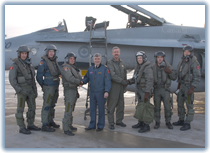 |
| 4 Wing Commander, Col Bill Cleland and the Commanding Officer of 410 Tactical Fighter Squadron congratulate the pilots and crew who were airborne for the 5,000,000 hour flown in the F-18 world wide.From left to right Flt.-Lt. Matt McCormack (Australian exchange pilot), Pte. Stephan LeBlanc, Capt Darwin MacMillan, Col Bill Cleland (Wing Commander), Lt.-Col. Bill Anderson (CO 410 Sqn.) Lt (N) Dave Morgan (USN exchange pilot), Capt Dave Turenne, Capt Seane Doell |
New Commandant Takes Osprey Ride
PATUXENT RIVER, Md. (NNS) -- General Michael W. Hagee, the new Commandant of the Marine Corps, entered his name into the history book of naval aviation Jan. 8 by taking the first VIP flight in the V-22 Osprey since the aircraft’s return to flight in late May of last year.
Osprey No. 21 was used for the 20-minute sortie, piloted by Lt. Col. Kevin Gross and Maj. Shawn Healy. The crew chief was Gunnery Sgt. Dennis Oliverio. The flight was conducted from Naval Air Station Patuxent River, Md., home of Naval Air Systems Command (NAVAIR) and headquarters for the V-22 Integrated Test Team (ITT).
“What a blast,” then Lt. Gen. Hagee said after the flight. “The acceleration when we converted from vertical to horizontal flight was unbelievable.”
In addition to the flight, during his visit to Southern Maryland, Hagee also received a program overview from Col. Dan Schultz, PMA-275, and offered words of encouragement and praise to a gathering of engineers and technicians from the Osprey’s ITT.
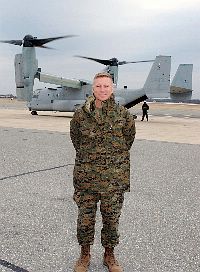 |
| Gen. Michael W. Hagee, new Commandant of the Marine Corps, takes the first VIP flight in a V-22 “Osprey” since the aircraft’s return to flight in late May of last year. The 20 minute flight was conducted from Naval Air Station, Patuxent River, Md., headquarters for the V-22 Integrated Test Team. U.S. Navy photo. |
“I want to congratulate the test team on all that’s been accomplished in recent months,” the general said. “The Marine Corps is depending on you to keep the press on in the future.”
Besides the flight crew, joining Hagee on the flight was Tom Laux, NAVAIR’s program executive officer for Air, Assault, Anit-Submarine Warfare, and Special Mission Programs.
NAVAIR provides advanced warfare technology through the efforts of a seamless, integrated, worldwide network of aviation technology experts.
Source: Navy News
Dexies Keep US Air Force Pilots Awake
WASHINGTON -- In the high-speed, high-stress environment of the combat aviator, it is a fact of life, and Air Force officials are doing what they can to ensure aircrew members are armed with the ability to fight an internal enemy that is potentially as deadly as a surface-to-air missile.
Fatigue was a contributing factor in 391 Air Force aircraft accidents from 1991 to 2002, Air Force safety officials said.
 |
| Sleep! Who needs sleep!? |
Those officials added that people who have been awake for 24-continuous hours react equivalent to someone with a blood alcohol content of .10, which is considered legally intoxicated in most states. A person who has been awake for 18-continuous hours has the equivalent BAC of .05.
That potential loss of motor skills is what prompted the Air Force to develop the fatigue-management program for aircrews who are tasked with extremely long missions.
According to Col. Tom Hyde, chief of "Checkmate," the Air Force chief of staff's directorate for air and space strategy development, the fatigue-management program is the pilot's set of tools to remain awake and alert during extremely long flights.
"The tools we have available are diet, exercise, sleep cycles and a medication program," Hyde said. "When you (use) all four in combination, it ends up being a reasonable and prudent approach in order to combat fatigue."
When a person is physically fit, Hyde said, the body is better able to handle stresses, including an interrupted sleep cycle, deployment and family separation.
Although most elements of the fatigue-management program are preflight, Hyde said there are some things crewmembers can do to stay alert even while strapped into their ejection seats. Those fatigue-fighting techniques include stretches, G-suit and oxygen system adjustments, and snacking.
The fatigue-management tool of last resort is a doctor-prescribed stimulant.
Only fighter and bomber crewmembers are authorized stimulants, Hyde said, because commanders have the option to augment tanker and airlift aircraft with additional pilots.
The "go pill," as it is commonly called, is a 5- or 10-milligram dose of Dexedrine. Dexedrine is the same medication routinely prescribed to treat attention deficit disorder. At the prescribed dosage, the stimulating effect of Dexedrine wears off after about four hours.
"The dosage is not too strong," Hyde said. "It's just designed to take the edge off."
Before pilots are authorized to fly after taking a "go pill," they must complete a prescribed testing protocol to determine how the medication will affect each pilot's body. The details are recorded in the pilot's medical records.
Before lengthy missions, and after consulting with their commanders and flight surgeons, pilots decide whether or not they want to take the pills with them on the mission. Then, it is up to the individual pilot as to whether or not to take the pill, Hyde said.
"When you walk out the door to fly (an) extended mission, do you have to take it with you? No," he said. "Is it advisable? Sure, but it's up to you whether or not to use it.
"It's (prescribed) under a doctor's care and with commander involvement," he said. "It's done with the full consent of the individual taking it."
Aircraft on bombing runs can approach a target at about 1,000 feet per second, Hyde said. In air-to-air engagements, aircraft can close in on each other at up to double that speed.
"When you get an idea of how fast things are moving through space, there is a lot that can happen as a result of a one- or two-second delay in making a decision," he said.
As a former squadron and group commander who has more than 3,300 flying hours, Hyde knows firsthand how fatigue can affect a pilot at those speeds.
"If you look at those instances where, after the fact, I said 'What was I thinking?' about 80 percent of the time it could be tied back to fatigue," he said.
"Fatigue's a killer out there," he said.
Air Force Risks Air Dominance Without F/A-22
WASHINGTON -- Without the F/A-22 Raptor, the Air Force could face losing its lead in fighter aviation to other nations, said Maj. Gen. John D. W. Corley, director of Air Force Global Power Programs at the Pentagon.
"We need this aircraft," Corley said. "It's the only new U.S. aircraft that will be able to put weapons on target this decade and be capable of defeating next-generation threats."
The Air Force sees the F/A-22 as the key enabler for joint and coalition forces to be able to operate around the clock without fear of attack. The Raptor will also enable the service to operate its other stealth assets - the B-2 Spirit, F-117 Nighthawk and Joint Strike Fighter -- during the day.
"If we begin to hobble this program and begin to reduce what is clearly the best strike aircraft that has ever been produced, then later this decade we will lose the ability to provide unchallenged air dominance over the battlefield for U.S. and allied forces," the general explained.
For more than half a century, American ground forces have not had to worry about threats from enemy aircraft. Corley said he worries that without the Raptor to meet and beat the challenges posed by the next generation of foreign aircraft, this could change.
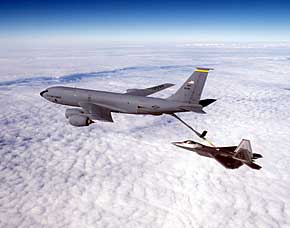 |
| Raptor 10, the first production representative F/A-22, makes its way to Edwards Air Force Base, Calif., with help from a KC-135 Stratotanker and crew from the 99th Air Refueling Squadron at Robins AFB, Ga. The aircraft will be used for the program's dedicated initial operational test and evaluation phase set to begin later this year. (Photo by Kevin Robertson) |
"That would be a dreadful first for us," he said.
Although there is an estimated $880 million cost increase to extend the engineering, manufacturing and development phase of the F/A-22 program, Air Force officials remain committed to funding any increase from within the program itself.
"We are confident that with the efficiencies and control measures we've put in place, and with better coordination with the contractor, we'll be able to deliver on a great aircraft within the constraints of the $43 billion procurement cap for the program," Corley said.
This extension of the EMD phase is not because of aircraft performance but increased time required addressing avionics software instability and fin buffet issues.
"The F/A-22 is a great aircraft, and its performance to date has been outstanding," he said. "The combination of all aspects -- stealth, supercruise, its revolutionary maneuverability and the integrated avionics -- will give us an unfair advantage over any enemy in the foreseeable future."
The Raptor is needed and Air Force leaders fully support and concur with a "buy-the-budget" philosophy for the F/A-22, according to the general.
"We aren't asking for a removal or expansion of the procurement cap," he said. "We just want the opportunity to make best use of the dollars by stabilizing this program so we can buy the greatest quantity of aircraft with the available dollars."
In the procurement world, reducing the number of aircraft being purchased does not always save money in the long run. In fact, as fewer aircraft are purchased, the cost per aircraft usually increases. If at a later date more aircraft are required, the aircraft must be purchased at an elevated price.
The Air Force experienced this with the C-17 Globemaster III program when it had to reduce the number of C-17s that it wanted to purchase because of similar program instability, Corley said.
However, when the plane finally entered service, the nation saw that there was still a need for more of them, he said. Even though the Air Force has purchased more aircraft, it is not been able to get back to the original cost and must pay a premium price per aircraft.
"Let's not repeat the same mistakes," Corley said. "Let's not keep chipping away at the F/A-22 program. Let's not cause the taxpayer to spend more money to subsequently buy back critical capability. There is an essential need for the F/A-22 in sufficient numbers, just as there was, and is, for the C-17.
"Let's take F/A-22 successfully through testing, stabilize the program and quickly ramp to production rates that field capability critical to our nation's defense," he said.
UAV Aircraft Launched From Submarine
ANNAPOLIS, Md. -- Northrop Grumman Corporation has completed the first of three tests designed to demonstrate that air vehicle payloads such as UAVs can be successfully launched from an inexpensive, expendable capsule after it is released from a submarine.
This test of the Stealthy Affordable Capsule System (SACS), performed in a test pool at the SRI Corral Hollow Experiment Site in Tracy, Calif., successfully met its goal of demonstrating the key technologies of this system, including capsule hydro-stability, payload support and payload ejection in the actual environment.
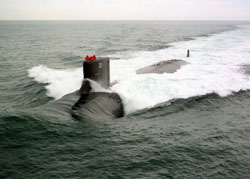 |
| Unmanned Air Vehicles (UAVs) from subs? This ought to add a new dimension to sub sims! |
The next step in the development process is to continue concept refinement including two additional waterborne tests to be held in February and August 2003. Once this phase of the contract is complete, SACS could be fitted with alternate payloads for a series of at-sea and submarine launched demonstrations.
The company is developing SACS under an agreement from Naval Sea Systems Command for the Submarine Payloads and Sensors program. Northrop Grumman is developing an affordable, flexible SACS concept for submarines of the future capable of interacting with a wide variety of payloads.
Northrop Grumman is a member of the Team 2020 Consortium that develops and demonstrates potential new technologies to maximize future submarine effectiveness.
Northrop Grumman Oceanic and Naval Systems, a unit of the company's Electronic Systems sector, designs, produces, tests and supports some of the world's most sophisticated undersea and naval systems.
Headquartered in Baltimore, Md., Northrop Grumman Electronic Systems is a world leader in the design, development and manufacture of defense electronics systems including airborne radar systems, navigation systems, electronic warfare systems, precision weapons, airspace management systems, air defense systems, communications systems, space systems, marine systems, oceanic and naval systems, logistics systems, and automation and information systems.
Source: Northrup Gumman
Moog To Repair F-16s
EAST AURORA, N.Y. -- Moog Inc. announced today that the company has received four contracts for original equipment and repair work on military aircraft.
BAE SYSTEMS Controls awarded the company a $12.8 million contract for flight control actuation systems on the Indian Light Combat Aircraft. Work will be performed by Moog's Aircraft Group in East Aurora with the first hardware scheduled for delivery in 2004. The Indian Light Combat Aircraft is a new light-weight, multi-role, supersonic combat aircraft.
The U.S. Air Force at Tinker Air Force Base in Oklahoma, awarded the company two five-year contracts for the repair, overhaul, and upgrade of certain flight control hardware on the F-16 Fighting Falcon. These orders total $14.9 million and establish Moog as the primary depot for overhaul of the F-16's Leading Edge Flap Power Drive Unit. Moog's Torrance Operations designed and built the Leading Edge Flap Drive System for the F-16 under contract to Lockheed Martin. The F-16 Fighting Falcon is an all-weather, supersonic, multi-role fighter aircraft. More than 4,000 aircraft were manufactured and are operated by eighteen countries.
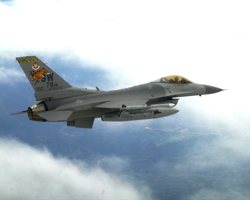 |
| Moog wins contract to repair F-16 Fighting Falcons. |
The Naval Inventory Control Point, Philadelphia, PA awarded the company a $7.9 million contract for repair work on the wingfold transmission for the F/A-18 C/D Hornet. The F/A-18 Hornet is the Navy's front-line fighter and attack aircraft. 1,255 F/A-18's were manufactured by the Boeing Company, St. Louis, MO and are operated by seven countries. Moog's Torrance Operations designed and built both the Leading Edge Flap and the Wingfold Systems for the F/A-18. The repair work will be a joint effort by Moog's Torrance, CA and Salt Lake City, UT Operations.
Moog Inc. is a worldwide manufacturer of precision control components and systems. Moog's high-performance actuation products control military and commercial aircraft, satellites and space vehicles, launch vehicles, missiles and automated industrial machinery.
Source: Moog Inc.
